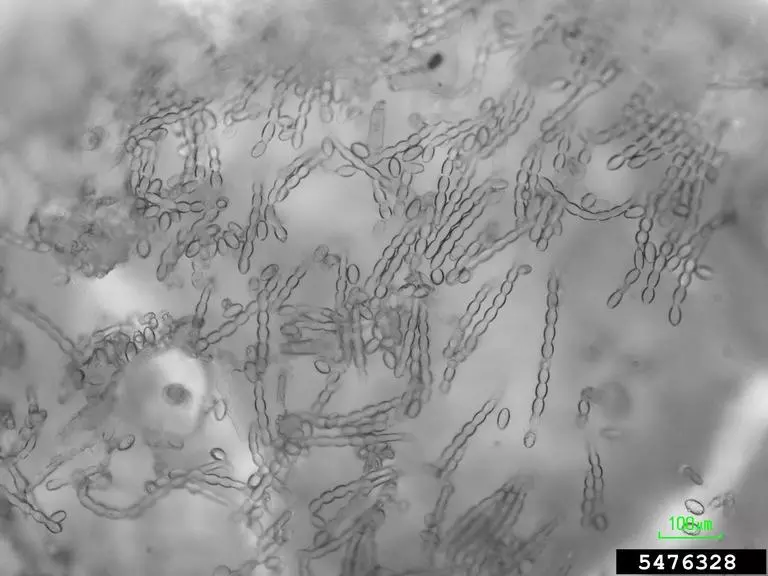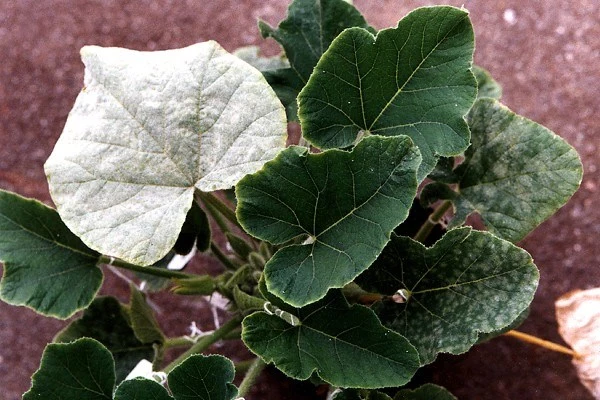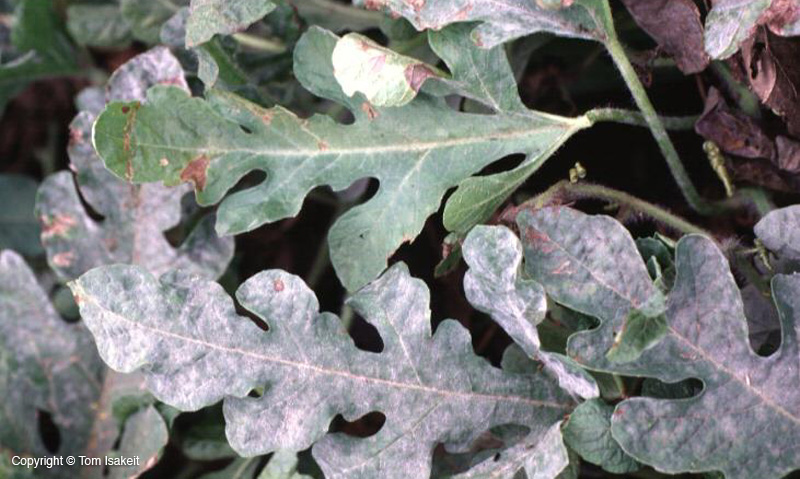
Written by: Becky Anderson
Published by: David Santos
What is Podosphaera xanthii?
Podosphaera xanthii is a pathogenic fungus which causes “powdery mildew” on plants, especially cucurbits [1]. The naming of this fungus is not standardized, and you may also know it as Podosphaera fusca, Sphaerotheca fuliginea or Sphaerotheca fusca [1]. In addition to P. xanthii, powdery mildew is caused by many other fungal species including in the genera Erysiphe, Microsphaera, Phyllactinia, Sphaerotheca, Uncinula and Leveillula, making it difficult to pinpoint the causative agent of powdery mildew.
Cucurbits – family of plants which includes pumpkins, squash, cucumbers, gourds, watermelons and cantaloupe
Powdery mildew is attributed to 30-50% crop loss in cucumbers [2] and over 40% crop-off in mungbeans [3]. It is also a problem in other crops, including hydroponically grown fruits and vegetables such as lettuce [4].

asexual reproduction: the act of reproducing from a single parent cell
Infection and Symptoms
Infection with powdery mildew disease occurs when spores, called conidia, land on the plant (typically on the leaf surface) and form small strands that enter the plant’s epidermal cells. Once inside the plant, long strands called hyphae develop, which, when combined with the conidia (spores), create the distinct white coating on the plant surface [1]. These spores typically spread through airborne transmission but can also spread through direct contact with contaminated objects/surfaces.
Spores: a cell produced by fungi used for sexual or asexual reproduction
Hypha(e): Long filamentous, branching structures used by fungi. Many hyphae are called mycelium.
Symptoms caused by P. xanthii are similar to other pathogens (e.g. Erysiphe, Microsphaera, Phyllactinia, Sphaerotheca, Uncinula and Leveillula). They are typically recognized as white powder on leaves and stems but rarely on the fruit [1]. The white powder can completely cover the leaves, inhibiting their photosynthetic abilities and leading to the death of the leaves (Figure 2). In addition, the lack of shelter and protection from the leaves can result in reduced fruit growth, sunburning and premature ripening [1], resulting in reduced crop production and loss.

Growth Conditions
Powdery mildew thrives in humid conditions (>70%), but this disease can continue to spread once the infection has begun. Powdery mildew can grow in temperatures between 16-30˚C (62-86˚F) but grows the fastest between 21-27˚C (70-80˚F).
We provide great overviews of many agricultural microorganisms. Subscribe to stay updated!
Treatment and methods of control
A traditional method of preventing disease within a greenhouse or hydroponic system is growing various crops, some with a natural resistance to certain diseases [5;6]. Growers have historically been breeding resistance into cucurbits, and it is one of the most common methods of disease control and prevention. Commercial lines of squash, melon and cucumbers have successfully been bred for resistance to P. fusca/P. Xanthii. Watermelon was thought to be naturally resistant to P. fusca/P. xanthii, but certain strains of the fungus can infect the crop, causing disease [7; 5; 8]
Recent technological advancements have produced methods of pathogenic control using other biological agents (check out our blog post on biocontrol methods). With regards to P. xanthii, non-pathogenic Bacillus subtilis (bacteria) and Trichoderma species (fungi) have shown protective properties on cucurbits, preventing powdery mildew caused by Podosphaera xanthii (9; 2; 10).
Biological agents: also known as biocontrol or biocontrol agents, is the use of non-pathogenic microbes to prevent or treat diseases caused by pathogenic microbes
Steps for controlling Podosphaera xanthii in greenhouses*
- Contact your seed supplier for resistant cultivar
- Restrict visitor access and personnel within the greenhouse
- Follow strict hygiene and good practices
- Thoroughly disinfect and dispose of crops (e.g. through burning) during year-end cleanup
- Control weeds in surrounding areas
- Keep ornamental and tropical plants outside of the greenhouse
- Modify the internal environment to reduce humidity and increase airflow
*These steps are the same as controlling powdery mildew caused by Leveillula taurica and were initially adapted from The BC Ministry of Agricultural, Food and Fisheries [11]. See the link below for further details.
Powdery mildew is a devastating disease which can be challenging to control once plants are infected. Due to the proximity of plants in a hydroponic farm or traditional greenhouse, this disease can spread rapidly from airborne spores and contact. In addition to the challenge of containing the fungi, powdery mildew is caused by diverse pathogens, making it impossible to identify what the causative agent is by just looking at the plant (Figure 3).

Figure 3. Powdery mildew on watermelon leaves, caused by Sphaerotheca fuliginea, Erysiphe cichoracearum. Image from https://aggie-horticulture.tamu.edu/vegetable/watermelon/foliar-diseases/powdery-mildew/
The good news is that Podosphaera xanthii is one of the fungal species we can detect using Pathogen+, a microbial surveillance service. Contact us at [email protected] to get started or to learn more about which program will best suit your needs.
Disclaimer
The information we present in Pathogen Profile is based on collating published peer-reviewed scientific literature and sources we think are reliable. This is by no means an exhaustive review of pathogens. Pathogen Profile gives a small glimpse of what is known about pathogens and we encourage growers to do more research on their own based on the pathogens in relation to their own crops and hydroponic systems. We are not plant pathologists thus the information presented in Pathogen Profile should not be used as professional advice to treat pathogens or operate your hydroponic system.
Works Cited
- Pérez-García A, Romero D, Fernández-Ortuño D, López-Ruiz F, De Vicente A, Torés JA. The powdery mildew fungus Podosphaera fusca (synonym Podosphaera xanthii), a constant threat to cucurbits. Mol Plant Pathol. 2009 Mar;10(2):153-60. doi: 10.1111/j.1364-3703.2008.00527.x. PMID: 19236565; PMCID: PMC6640438.
- Hafez, Y. M., Attia, K. A., Kamel, S., Alamery, S. F., El-Gendy, S., Al-Doss, A. A., Mehiar, F., Ghazy, A. I., Ibrahim, E. I., & Abdelaal, K. A. A. (2020). Bacillus subtilis as a bio-agent combined with nano molecules can control powdery mildew disease through histochemical and physiobiochemical changes in cucumber plants. Physiological and Molecular Plant Pathology, 111, 101489. https://doi.org/10.1016/j.pmpp.2020.101489
- Kelly, L. A., Vaghefi, N., Bransgrove, K., Fechner, N. A., Stuart, K., Pandey, A. K., Sharma, M., Németh, M. Z., Liu, S.-Y., Tang, S.-R., Nair, R. M., Douglas, C. A., & Kiss, L. (2021). One crop disease, how many pathogens? podosphaera xanthii and erysiphe vignae sp. nov.. identified as the two species that cause powdery mildew of Mungbean (vigna radiata) and Black Gram (v. mungo) in Australia. Phytopathology®, 111(7), 1193–1206.https://doi.org/10.1094/phyto-12-20-0554-r
- B. Mieslerová, M. Kitner, E. Křístková, Ľ. Majeský & A. Lebeda (2020) Powdery Mildews on Lactuca Species – A Complex View of Host-Pathogen Interactions, Critical Reviews in Plant Sciences, 39:1, 44-71, DOI: 10.1080/07352689.2020.1752439
- Jahn, M. , Munger, H.M. and McCreight, J.D. (2002) Breeding cucurbit crops for powdery mildew resistance In: The Powdery Mildews. A Comprehensive Treatise (Bélanger R.R., Bushnell W.R., Dik A.J. and Carver T.L.W., eds), pp. 239–248. Saint Paul, MN: APS Press.
- Zitter, T.A. , Hopkins, D.L. and Thomas, C.E. (1996) Compendium of Cucurbits Diseases. Saint Paul, MN: APS Press.
- Cohen, Y. , Baider, A. , Petrov, L. , Sheck, L. and Voloisky, V. (2000) Cross‐infectivity of Sphaerotheca fuliginea to watermelon, melon and cucumber. Acta Hort. 510, 85–88.
- Del Pino, D. , Olalla, L. , Pérez‐García, A. , Rivera, M.E. , García, S. , Moreno, R. , De Vicente, A. and Torés, J.A. (2002) Occurrence of races and pathotypes of cucurbit powdery mildew in southeastern Spain. Phytoparasitica, 30, 459–466. https://doi.org/10.1007/BF02979750
- Hafez, Y. M., El-Nagar, A. S., Elzaawely, A. A., Kamel, S., & Maswada, H. F. (2018). Biological control of Podosphaera xanthii the causal agent of squash powdery mildew disease by upregulation of defense-related enzymes. Egyptian Journal of Biological Pest Control, 28(1). https://doi.org/10.1186/s41938-018-0058-8
- Romero, D., de Vicente, A., Rakotoaly, R. H., Dufour, S. E., Veening, J.-W., Arrebola, E., Cazorla, F. M., Kuipers, O. P., Paquot, M., & Pérez-García, A. (2007). The Iturin and fengycin families of lipopeptides are key factors in antagonism of bacillus subtilis toward podosphaera fusca. Molecular Plant-Microbe Interactions®, 20(4), 430–440. https://doi.org/10.1094/mpmi-20-4-0430
- The BC Ministry of Agricultural, Food and FIsheries https://www2.gov.bc.ca/assets/gov/farming-natural-resources-and-industry/agriculture-and-seafood/animal-and-crops/plant-health/phu-powderymildew-greenhousepeppersss.pdf
Looking for more useful info? Go back to the Blog Page or check out the Resources Page.




